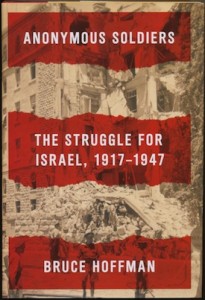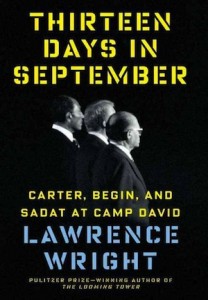Does terrorism work? This is the question that opens Anonymous Soldiers: The Struggle for Israel, 1917-1947 (Alfred A. Knopf, 2015). Western leaders insist that the work of terrorists will never lead to the ends they seek, but one of the lessons from this book is that this may well be wishful thinking.
 Anonymous Soldiers – the title is from the anthem of the Irgun, the Zionist paramilitary force led by Menachem Begin – is the latest book by Bruce Hoffman, an expert on terrorism.
Anonymous Soldiers – the title is from the anthem of the Irgun, the Zionist paramilitary force led by Menachem Begin – is the latest book by Bruce Hoffman, an expert on terrorism.
In the aftermath of the First World War and the collapse of the Ottoman Empire, Britain came to control the region known as Palestine, a victory that would prove confounding and tragic. Hoffman’s book is a story of endless miscalculations, under-preparedness and overreactions on the part of the British military and police.
The Balfour Declaration of 1917 was a statement of intent by the British government to create a Jewish national homeland in Palestine and the Jewish people there and elsewhere saw this as a sign that Britain would be their fiercest ally. However, almost from the moment the British Mandate began, until the forces of the empire departed with their tails between their legs three decades later, Palestine was riven with not only violent clashes between its Arab and Jewish residents, but by both those parties against the British and, as brutally detailed by Hoffman, fraternal conflict between Jewish militias.
The Haganah was the “establishment” militia, associated with the Jewish Agency and intended as a self-defence organization after the British proved incapable of or unwilling to protect the Jews of Palestine. In 1929, Arab riots led to mass killings of Jews and, while British police killed almost as many Arabs as the Arabs killed Jews, the balance demonstrated an inability of the British police and military to control the area. The diplomatic response was to attempt to appease the Arabs, which appears to be the first example in the book to prove that terrorism works.
The riots led to an investigative commission, a white paper and another British obfuscation on Zionism. The white paper blamed Arab violence on “excessive” Jewish immigration to the area in the mid-1920s and the purchases of land by Jews. This led some Zionists – notably those of Ze’ev Jabotinsky’s Revisionist party – toward the idea that Britain may not be a reliable ally. In 1931, Revisionists defected from the Haganah and formed Haganah-bet (later the Irgun), which did not see itself solely as a self-defence force but opened the door to “sabotage, bomb making and hit-and-run attacks – in other words, the core tactics of terrorism.”
From 1936 to 1939, Palestine was in a state of near civil war in the form of an uprising by the Arab populations against the British and the potential of more Jewish migration. At precisely this time, the fate of Jews in Europe was being sealed and countries, including Canada, were slamming shut the gates.
Clouds of war in Europe were accompanied by fear of Muslim uprisings in the vast British Empire. The priority, in the words of foreign secretary Lord Halifax, was to avoid “arousing antagonism with the Arabs.” Neville Chamberlain, the prime minister at the time, said it was “of immense importance to have the Muslims with us. If we must offend one side, let us offend the Jews rather than the Arabs.”
This, too, was a miscalculation that did not take into account the determination of the Irgun. British caving in the face of Arab violence was taken by the Irgun as proof that terrorism works.
And a third group, which had broken away from the Irgun – Lehi, also known as the Stern Group (or the Stern Gang by the British) – went further. They attempted an alliance with the Axis, viewing Hitler as “just another antisemite” and proposing a mutually beneficial partnership based, the author writes, “on the fatally erroneous assumption that for Hitler the crux of the Jewish problem in Europe could be solved by evacuation, not annihilation.”
Meanwhile, as terror was rocking the Middle East, Chaim Weizmann, the Zionist leader who was plugged into the British establishment, was mending fences in London and urging the Haganah to crack down on the Irgun and Lehi.
Weizmann was warned by then prime minister Winston Churchill that if the violence didn’t end, “we might well lose interest in Jewish welfare.”
Of course, the Irgun did not expect to defeat the British Empire militarily. “History and our observation,” Begin later said, “persuaded us that if we could succeed in destroying the government’s prestige in Eretz Israel, the removal of its rule would follow automatically.”
Weizmann’s diplomacy and the cooperation of the Haganah with the British forces in Palestine regained the trust of Churchill, but that was of limited value after the war leader lost the 1945 election and the Labor party came to power at Westminster.
The new prime minister, Clement Atlee, inherited a paralyzed Palestine, in which there seemed to be no winning position. At a 1947 conference, the British tried to share the mess with the United States, but that failed and they eventually dumped the problem at the podium of the new United Nations.
So, does terrorism work? In the Palestine example, Hoffman demonstrates that the Arab riots of 1921 resulted in restrictions on Jewish immigration to Palestine and the 1929 riots resulted in Britain backpedalling from its commitment to Zionism. The Arab Rebellion, from 1936 to 1939, resulted in a huge reconsideration of Britain’s policy in Palestine and, though the author doesn’t make this explicit, possibly the deaths of millions of European Jews.
On the Jewish side, violence seems to have had its intended effect, as well. “By September 1947, the Irgun had achieved its objective,” Hoffman writes. “Each successive terrorist outrage illuminated the government’s inability to curb, much less defeat, the terrorists. Already sapped by World War II, Britain’s limited economic resources were further strained by the cost of deploying so large a military force to Palestine to cope with the tide of violence submerging the country.”
The author sees the Irgun’s campaign as critical to understanding the evolution and development of terrorism in the second half of the 20th century and the already bloody 21st century. “Indeed, when U.S. military forces invaded Afghanistan in 2001, they found a copy of Begin’s seminal work, The Revolt, along with other books about the Jewish terrorist struggle, in the well-stocked library that al-Qaeda maintained at one of its training facilities in that country.”

